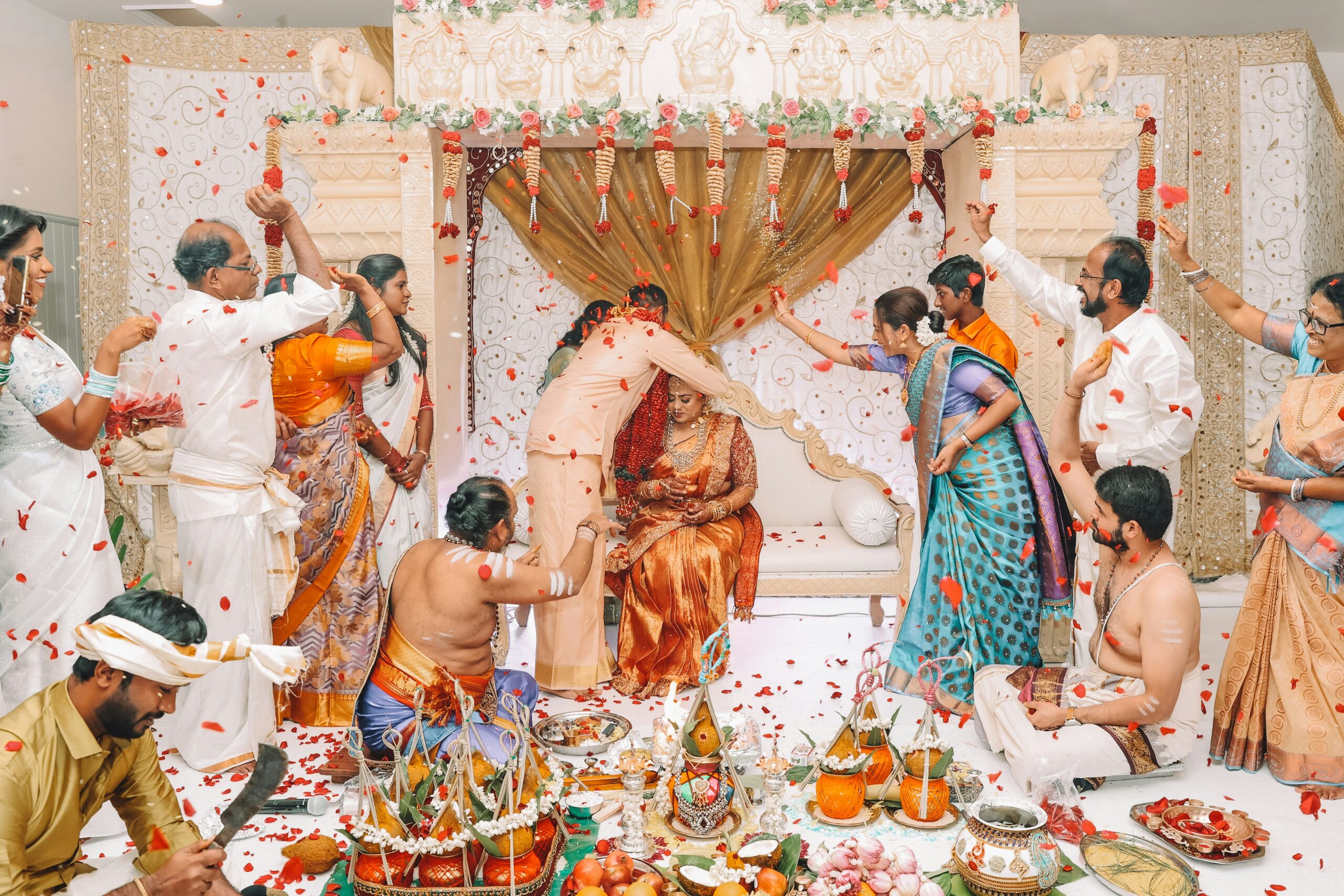Discover India’s Stunning
Wedding Destinations
Wedding Theme – Your Perfect Celebration
Royal Weddings

- Jaipur
- Udaipur
- Jodhpur
- Jaisalmer
Ganga River Valley Weddings

- Rishikeshr
- Haridwar
Beach Weddings

- Goa
- Kerala
- Andaman
- Daman Diu
Hill Station Weddings

- Nainital & Bhimtal
- Manali
- Dharamshala
- Mussoorie
Temple Weddings

- Trijuginarayanr
Plan Every Detail with Perfection
Venue Selection
- The foundation of the wedding.
- Chosen based on budget, style, convenience, personality, and theme.
- Options range from beach weddings to palaces, countryside, or religious backdrops.
- Includes creative décor ideas and affordable arrangements.
Decoration
- Sets the theme and mood of the wedding.
- Covers flowers, fabrics, props, lighting, and table décor.
- Also designed for pre-wedding functions like Mehendi, Sangeet, Cocktail, Bachelor’s/Hen’s parties.
- Goal: Transform the venue into a warm, personalized space.
Invitation
- The first impression of the wedding.
- Evolved from simple sweet boxes and cards to video invites, theme-based or caricature cards, handmade invitations.
- Services include design, color, font, packaging, and gift box selection.
- Ensures timely delivery and creativity.
Catering Services
- A wedding is remembered for its food.
- Menu curated as per taste, theme, and cultural preferences.
- Focus on lip-smacking food, beverages, table setup, and service quality.
- Goal: Guests enjoy, while hosts stay stress-free.
Boarding & Transportation
- Hassle-free logistics: pickup/drop, flight/train/bus bookings.
- Coordination of a fleet of cars/vehicles for guests.
- Ensures punctuality and avoids delays at every event
- Goal: Transform the venue into a warm, personalized space.
Photo & Videography
- Capturing candid memories for life.
- Professional photographers/videographers with the latest equipment.
- Includes pre-wedding shoots, ceremony coverage, and cinematic wedding films.
- Goal: Transform emotions into timeless keepsakes.
Indian Weddings
Ritual Guide
Experience the beauty of India’s diverse wedding traditions, where each region celebrates love with unique customs, colors, and rituals.
North Indian Hindu Weddings
- Grand baraats, fire rituals, music
- Bride: Lehenga | Groom: Sherwani.
- Central ritual: Saptapadi (seven steps around sacred fire)


South Indian Hindu Weddings
- Typically held in temples.
- Bride: Kanjeevaram silk saree | Groom: traditional attire
- Sacred moment: Groom ties thaali/mangalsutra.
Bengali Hindu Weddings
- Bride enters on wooden stool (pidi), groom applies sindoor.
- Rituals include Shubho Drishti.
- Traditional attire: Red-and-white saree


Gujarati Hindu Weddings
- Ganesh Puja, Mangal Phera, Jaimala, Aeki-Beki post-wedding games.
Jain Weddings
- Focus on simplicity, spirituality, non-violence.
- Temple ceremonies with vegetarian cuisine.


Sikh Weddings (Anand Karaj)
- Ceremony in Gurdwara with Guru Granth Sahib.
- Central ritual: Laavan – couple walks four times around scripture.
Christian Weddings
- Church ceremony with vows, ring exchange, priest blessing.
- The ceremonies symbolize not just love, but also duty (dharma), prosperity (artha), desire (kama), and spiritual liberation (moksha)
- Multiple Days of Celebration, Weddings often span 3–7 days, with pre-wedding, main wedding, and post-wedding rituals


Hindu Weddings
- Hindu weddings are deeply tied to Vedic traditions and involve fire (Agni) as a witness.
- Rituals and traditions vary widely from one region to another and among different communities, showcasing the incredible cultural diversity of India.
- Hindu weddings, while diverse in their details, all embrace cherished traditions, foster family togetherness, and seek blessings from the divine.
North Indian Wedding Overview
Pre-Wedding Ceremonies
These set the mood for celebration and involve fun, family bonding, and rituals.
- Roka Ceremony: The formal announcement of the match
- Engagement (Sagai): Exchange of rings, gifts, and blessings.
- Mehendi Ceremony: Bride’s hands and feet decorated with henna; singing and dancing
- Sangeet Ceremony: Night of music and dance; traditionally women’s songs, now big Bollywood-style events
- Tilak/Sagan: Groom’s family formally welcomed by bride’s family with gifts
- Haldi Ceremony: Turmeric paste applied to bride and groom for beauty and purification.
Wedding Day Ceremonies
The wedding day is full of pomp, processions, and sacred rituals
- Baraat: Groom arrives in a grand procession (often on horseback or decorated car) with music and dance.
- Milni: Families exchange garlands at the venue entrance
- Jaimala: Bride and groom exchange floral garlands as acceptance of each other.
- Kanyadaan: Bride’s father gives her hand to the groom, entrusting him with her well-being.
- Mangal Pheras: Couple circles the sacred fire (Agni) seven times while mantras are chanted.
- Saptapadi (Seven Steps): Each step is a vow taken together for lifelong commitment.
- Sindoor & Mangalsutra: Groom applies vermillion (sindoor) on bride’s hair parting and ties mangalsutra around her neck — symbols of married life.
Post-Wedding Ceremonies
Traditions to welcome the bride into her new home and bless the couple.
- Vidaai: Emotional farewell of the bride from her parental home
- Griha Pravesh: Bride’s first entry into groom’s home; tips rice pot for prosperity.
- Mooh Dikhai: Groom’s family formally sees the bride and blesses her with gifts.
- Reception: Grand celebration hosted by the groom’s family.
- Pag Phera: Bride returns to her parental home for a short stay, symbolizing continued ties.
Distinctive Features
These set the mood for celebration and involve fun, family bonding, and rituals.
- Grandeur & Festivity: Known for big processions, lavish décor, and vibrant dances.
- Fire (Agni) Rituals: Central to marriage vows, as Agni is considered the divine witness.
- Garlands & Vows: Acceptance and bonding are symbolized by jaimala and saptapadi.
- Blend of Fun & Sacredness: Rituals mix deep spirituality with playful customs (like stealing the groom’s shoes – Joota Chupai).
Gujarati Weddings
Gujarati weddings are some of the most colourful, lively, and playful in India.
While they share common Hindu wedding elements (like pheras and vidaai), they
also have distinct rituals that make them unique.
Chandlo Maatli
- Groom’s forehead is marked with a chandlo (red vermillion circle)
- Bride’s family formally accepts the marriage proposal.
Gol Dhana (Sagaai / Engagement)
- Gol = jaggery, Dhana = coriander seeds
- These are distributed to symbolize sweetness and prosperity.
- Rings exchanged, marking the official engagement.
Mameru Ceremony
- Bride’s maternal uncle (mama) visits her with gifts like a saree, jewelry, and sweets.
- Strengthens the maternal side’s role in the wedding
Pithi Ceremony
- Bride and groom are smeared with turmeric, sandalwood, and rosewater paste.
- Purifies and beautifies them before the wedding.
Sanji / Sangeet Sandhya
- A night of Garba and Raas dancing.
- Entire families come together for singing and traditional folk music.
Mandap Mahurat
- Sacred rituals performed to sanctify the mandap (wedding canopy) before the wedding.
Griha Shanti
- Rituals to pacify planets (grahas) and ensure harmony in the new married life.
Wedding Day – Pheras & Mangal Phera
- Couple circles the sacred fire four times (not seven, as in many Hindu weddings)
- Each phera has a unique vow, focusing on family, values, and harmony
. Aeki Beki (Post-wedding Game)
- A fun, symbolic game.
- A silver dish filled with milk, sindoor, and coins is prepared
- The bride and groom search for a ring — whoever finds it more often is said to “rule the household”!
Ghar Nu Laxmi
- When the bride enters her new home, she is seen as Lakshmi, goddess of prosperity.
- She gently tips a vessel of rice with her right foot, symbolizing abundance
Why Gujarati Weddings
Stand Out
- Blend of spiritual (Ganesh Sthapan, Griha Shanti) and playful (Aeki Beki, Garba) elements
- Strong involvement of the maternal family (Mameru).
- Only four pheras instead of seven.
- Emphasis on music, dance, and community joy.

Bengali Wedding
Bengali weddings are among the most vibrant, traditional, and culturally rich in
India, full of music, rituals, and symbolism. They beautifully blend spiritual devotion,
family bonds, and playful customs.
Pre-Wedding Rituals
- List Item #3Aashirbaad (Blessing Ceremony): Both families bless the bride and groom with rice and durba grass for prosperity
- Ai Buro Bhaat: The bride/groom’s last unmarried feast with traditional Bengali food like fish, rice, and sweets
- Gaye Holud (Turmeric Ceremony): A fun ritual where family members smear turmeric paste on the bride and groom for purification and glow
- Sankha & Pola: Bride receives white (sankha – conch shell) and red (pola – coral) bangles, along with a mukut (head ornament)
Wedding Day Rituals
- Bor Jatri (Groom’s Procession): Groom arrives at the venue with family and friends in a lively procession.
- Bor Boron: Groom is welcomed with aarti, sweets, and water at the entrance by the bride’s mother
- Saat Paak: The bride is seated on a wooden stool (pidi) and lifted by brothers or cousins. She circles the groom seven times, covering her face with betel leaves
- Shubho Drishti: The bride finally unveils her face and makes eye contact with the groom for the first time in the ceremony — considered very auspicious
- Mala Badal: Exchange of garlands between bride and groom, symbolizing acceptance.
- Sampradan: Formal handing over of the bride by her father/guardian
- Yagna & Saptapadi: Sacred fire rituals and seven steps around the fire, sealing the marriage vows.
- Sindoor Daan: Groom applies vermillion (sindoor) on the bride’s hair parting
- Ghomta: Bride’s head is covered with a new sari gifted by the groom’s family.
Post-Wedding Rituals
- Bidaai (Vidaai): Emotional farewell of the bride from her parental home
- Bou Bhaat: Bride cooks and serves rice for her in-laws, symbolizing her role as the new homemaker.
- Reception: Groom’s family hosts a grand feast in honor of the new coupl
Unique Features of Bengali Weddings
- Saat Paak & Shubho Drishti (playful reveal of the bride)
- Mala Badal done on an elevated stool, with friends/family teasing.
- Gaye Holud full of turmeric, laughter, and sweets.
- Fish & mishti (sweets) are integral to rituals and feasts.
- Brides wear red or maroon Banarasi sarees, grooms often wear dhoti-kurta.

